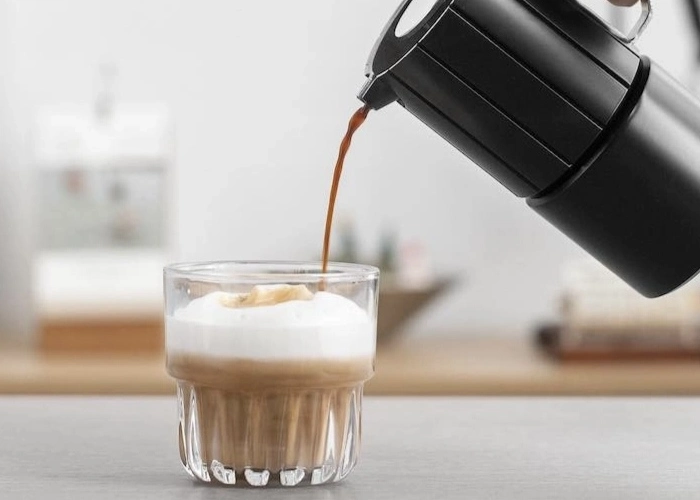Espresso is a concentrated coffee beverage known for its rich flavor and velvety crema. Traditionally, it is made using an espresso machine, which forces hot water through finely-ground coffee under high pressure. But what if you don’t have an espresso machine? Can you make espresso in a regular coffee pot? This article explores the possibilities, limitations, and alternatives for brewing espresso-like coffee without specialized equipment.
Understanding Espresso & Its Requirements
Espresso is distinct from regular drip coffee in several ways. The brewing process involves high pressure—typically 9 bars—to extract flavors quickly, resulting in a concentrated shot. The grind size is fine, almost like powdered sugar, and the extraction time is short, usually 25 to 30 seconds.
A standard coffee pot, such as a drip brewer or percolator, operates differently. It uses gravity to pass water through coarser grounds, resulting in a milder, less concentrated brew. The lack of pressure means it cannot produce true espresso. However, with some adjustments, you can get a stronger, espresso-like coffee.
Why a Coffee Pot Can’t Make True Espresso
The primary issue with using a coffee pot for espresso is the absence of pressure. Espresso machines generate the necessary force to extract oils, solubles, and crema—the golden foam on top of a well-pulled shot. A drip coffee maker simply doesn’t have this capability.
Another factor is temperature. Espresso requires water at around 195°F to 205°F (90°C to 96°C). While some coffee pots reach this range, they don’t maintain consistent heat during extraction, which affects flavor.
Finally, grind size and brewing time differ. Espresso needs a fine grind and a short contact time, whereas drip coffee uses a medium grind and longer extraction. Even if you use finely ground coffee in a coffee pot, the result will be over-extracted and bitter rather than rich and balanced.
Methods to Mimic Espresso with a Coffee Pot
While you can’t make true espresso in a coffee pot, you can approximate its strength and intensity. Here are some techniques to try:
Using a Moka Pot (Stovetop Espresso Maker)
A Moka pot is often called a “stovetop espresso maker,” though it doesn’t produce real espresso. It uses steam pressure to push water through coffee grounds, creating a strong, concentrated brew. While the pressure is lower than an espresso machine (about 1 to 2 bars), the result is closer to espresso than drip coffee.
To use a Moka pot, fill the bottom chamber with water, add finely-ground coffee to the filter basket, and assemble the pot. Heat it on the stove until the water boils and forces its way into the upper chamber. The resulting coffee is bold and rich, though lacking crema.
Making Strong Drip Coffee
If you only have a drip coffee maker, you can adjust your method to produce a stronger brew. Use a finer grind than usual—but not as fine as espresso—to increase extraction. Reduce the water-to-coffee ratio; instead of the standard 1:16 (coffee to water), try 1:12 or even 1:10. This makes a more concentrated cup, though it still won’t match espresso’s intensity.
Using an AeroPress
The AeroPress is another alternative. While not a coffee pot, it’s an affordable and portable device that can make espresso-like coffee. By using finely-ground coffee, hot water, and manual pressure, you can produce a concentrated shot. Some baristas even use the AeroPress in competitions due to its versatility.
Limitations of Using a Coffee Pot for Espresso
The biggest drawback is the lack of crema, which is a hallmark of espresso. Crema forms when oils emulsify under high pressure, something a coffee pot cannot achieve. Additionally, the flavor profile will be different—more akin to strong coffee than true espresso.
Another issue is consistency. Without precise control over temperature, pressure, and extraction time, each brew may vary in strength and taste. Espresso machines are designed for repeatability, whereas coffee pots are not.
Alternative Brewing Methods for Espresso-Like Coffee
If you’re determined to make something close to espresso without a machine, consider these methods:
French Press with Fine Grind
A French press can produce a robust, full-bodied coffee. Use a finer grind than usual and steep for about four minutes. While it won’t be espresso, the immersion method extracts more oils, creating a richer cup.
Turkish Coffee
Turkish coffee is finely ground and boiled with water, resulting in a thick, potent brew. It’s not espresso, but it’s one of the strongest coffee preparations. The fine particles remain in the cup, adding texture and intensity.
Cold Brew Concentrate
Cold brew isn’t espresso, but a concentrated version can be used similarly. Steep coarsely-ground coffee in cold water for 12 to 24 hours, then dilute with hot water for a strong, smooth drink.
Should You Try Making Espresso in a Coffee Pot?
While a standard coffee pot can’t make true espresso, it can produce a strong, concentrated coffee that might satisfy your cravings. If you want something closer to espresso, a Moka pot or AeroPress is a better choice. Understanding the differences between brewing methods helps set realistic expectations.
For coffee enthusiasts, investing in an espresso machine is the best way to enjoy authentic espresso at home. However, if you’re in a pinch, experimenting with your coffee pot can still yield a decent, bold cup.
Conclusion
Espresso requires specific conditions—high pressure, fine grind, and precise temperature—that a coffee pot cannot provide. While you can make strong coffee with a drip brewer, it won’t match the depth and crema of real espresso. Alternative methods like the Moka pot or AeroPress offer better approximations. If espresso is your goal, specialized equipment is the way to go. Otherwise, adjusting your coffee pot’s settings can still deliver a satisfying, robust brew.
Related topics:
Best Espresso Pods for Nespresso
Where to Buy Gaggia Espresso Machines: A Complete Guide
Buon Giorno Coffee: A Journey to Exceptional Espresso & Beyond


